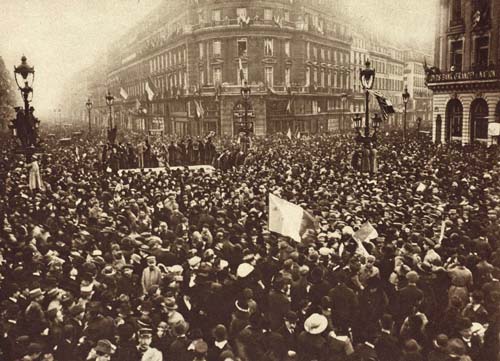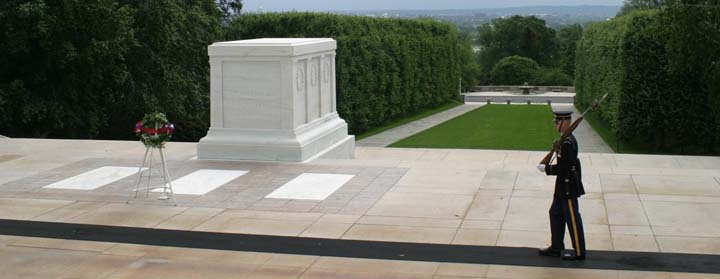Armistice and After
|
Armistice celebration in Paris - reserve
|
Theodore Roosevelt planned to run again for president, but his health declined and he died January 6, 1919, at his home in Oyster Bay. His sons Ted, Jr., and Archie were demobilized from the 1st Division and returned to the U. S., but Quentin Roosevelt's Nieuport crashed near Chamery and he was buried where he fell. When the French offensive from Soissons took this village, his grave became a shrine.
Eleanor Roosevelt, wife of Theodore Roosevelt, Jr., was a YMCA volunteer in France, and persuaded Pershing to allow wives to visit husbands. Pershing set up leave centers at Aix-Les-Bains and elsewhere to keep doughboys away from Paris.
Assistant Secretary of the Navy Franklin D. Roosevelt had gone to Europe July 10 on new destroyer USS Dyer, did not get near any of the cities in France being bombed by German Gothas, such as Amiens and Abbeville, but visited Chateau-Thierry and Belleau Wood, saw dead Germans at Mareuil-en-Dole north of Fere-en-Tardenois, pulled the lanyard of a 155 artillery gun, went to Rome to urge Orlando to use the Italian Fleet in the Mediterranean, toured the Belgian coast, inspected America's European squadron in England, caught pneumonia, was bedridden on his return to New York when Eleanor found his love letters from Lucy Mercer. He would run for vice-president with Cox in the 1920 election campaign, but the Wilsonian Democrats would lose to Warren Harding and the isolationist Republicans. Althoug stricken with polio in 1921, FDR became governor of New York in 1928 and the only four-term president of the United States 1933-45.
Lt. Wendell Willkie in the 325th Artillery never saw combat, became a lawyer in Akron, Ohio, rose in 1933 to president of Commonwealth & Southern, the nation's largest private utility company, changed from a Wilsonian Democrat to a conservative Republican, opposed the New Deal and unsuccessfully challenged FDR for the presidency in 1940.
Capt. Harry S Truman of Battery D, the Kansas National Guard unit in the 129th Field Artillery, 35th Division, that fought in the Argonne, wrote a letter in 1918 to his future wife Bess Wallace that he wanted to go into politics to rid the army of elitist West Point regular army officers. With the help of former Lt. James Pendergast, nephew of Kansas City political boss, Tom Pendergast, Truman won election as county jundge, then U. S. Senator from Missouri in 1934, becoming FDR's Vice-President in 1945.
The "Millionaire's Unit" of 28 Yale volunteers who became the first Naval Aviation squadrons in Nov. 1917 returned home to distinguished careers. Trubee Davison who owned the home at Peacock Point on Long Island where the Yale Aero Club began in 1916, became the first Assistant Secretary of War for Air in 1926, and president of the American Museum of natural History in New York, and in 1951 became the first CIA director of personnel. David Ingalls marryied Standard Oil heiress Louis Harkness and became the first Assistant Secretary of Navy. Juan Trippe founded Pan American Airways in 1927. Artemus Gates became president of New York Trust that would merge into J. P. Morgan Chase & Company. Robert Lovett became a partner in Brown Brothers bank, and in 1931 with Prescott Bush and Averell Harriman merged into the Brown Brothers Harriman & Company, the nation's largest private bank. Lovett would be appointed Assistant Secretary of War for Air by his feloow Yale Skull and Bones classmate Henry Stimson, helped create the independent USAAF in 1941, and became one of the original Wise Men of the Cold War State Department under George Marshall, and Secretary of Defense in 1951.
Pvt. Harold Ross and Alexander Woollcott left the Stars and Stripes that they had managed for 14 months to return to New York and would found the New Yorker magazine in 1925 and its associated group of intellectuals, the Algonquin Round Table. Lt. Grantland Rice of the 115th Field Artillery had also worked on the Stars and Stripes, later became a leading sports writer with his "Spotlight" column in New York, wrote the Four Horseman article after Notre Dame beat Navy in 1924. Steve Early left the Stars and Stripes to become a UP reporter, editor of Paramount Newsreel, and in 1933 Franklin Roosevelt's press secretary.
Walt Disney was only 15 when America entered the war, so his mother forged a birth certificate to allow him to join the Red Cross as an ambulance driver. While in France in 1918 he decorated his ambulance with cartoon characters, returned after the war to kansas City, tried to start a cartoon business with Ub Iwerks (whose Oswald the Lucky Rabbit became Bugs Bunny at Warner Bros. Looney Tunes). Walt moved to Hollywood in 1923 and with his brother Roy started the animation business that produced Mortimer the Mouse and finally "Steamboat Willie" in 1928, the first sound animated cartoon.
Choctaw Pvt. Joseph Oklahombi returned to farming and hunting at his home in the Kiamichi Mountains of southeast Oklahoma. In Oct. 1918 with the 141st Infantry in the 36th Division at the Battle of Blanc Mont in the Champagne sector, he had captured German guns and with the survivors of his Company D held off attacks for 4 days and took 171 German prisoners, more than Sgt. York took in the Argonne. He and his fellow Choctaw soldiers in the 142nd Infantry were considered the first "code talkers" when they spoke in their native language as telephone operators. Of the 200,000 Native-Americans in the U.S., 12,500 served in the Army and 1,000 in the Navy during the war. Their service compelled Congress to pass the Indian Citizenship Act of 1919 and to grant blanket citizenship to all Native-Americans in 1924.
Mexican immigrant Pvt. Marcelino Serna returned to the U.S. as the most decorated soldier from Texas. In the battle of the Argonne, he was a scout in Company B, 355th Infantry, 89th Division, led an attack on German machine guns, followed a German sniper into a trench, killed 26 and captured 24 with with a .45 automatic in one hand and a Luger in the other. Only four days before the armistice, he was wounded in both legs. He returned to El Paso, became a citizen in 1924, retired in 1960 as a hospital plumber. He was one of 5794 undocumented Mexican-Americans that served in the war.
Veterans of the AEF created the American Legion in Paris March 17, 1919, returned home to establish local Posts in 15,000 towns and cities in all 50 states with over 1 million members by 1931. The Legion lobbied Congress to create the Veterans Bureau in 1921 and the Veterans Administration in 1930.
Four bodies of unknown American soldiers were removed from four cemeteries in France in 1921, taken to the Hotel de Ville in Paris, one body was selected for transport to Arlington National Cemetery to be interred in the Tomb of the Unknown Soldier Nov. 11, 1921, following the custom established by the British on Nov. 11, 1920, at Westminster Abbey and the French in January 28, 1921 at the Arc de Triomphe. In 1923, Congress established the American Battle Monuments Commission to maintain the cemeteries of American soldiers in foreign countries. According to John Keegan, the Great War's chief heritage were the many graveyards, of the German fleet scuttled at Scapa Flow, the 600 cemeteries created by the Imperial War Graves Commission for 1 million British dead, and the American Battle Monuments Commission created 24 cemeteries for 30,921 Americans killed in the war.
|
Oise-Aisne Cemetery near Tardenois
|
Links:
- Military Casualty Information from Department of Defense
- Walt Disney Family Museum in the San Francisco Presidio
Sources:
- Campbell, Matt. "For historian, the ‘Big One’ is still a big deal," The Kansas City Star, Dec. 01, 2006 article
- Keegan, John. The First World War. New York : A. Knopf, 1999.
- Lowry, Bullitt. Armistice 1918. Kent, OH: Kent State University Press, 1996. 245 p.
- Rudin, Harry R. Armistice, 1918. New Haven CT: Yale University Press, 1944. 442 p. CL D641 .R8 1944
- Wortman, Marc and Patrick Girard Lawlor. The Millionaires' Unit: The Aristocratic Flyboys Who Fought the Great War and Invented American Air Power. New York: PublicAffairs, 2006.
Maps:
- Maps from USMA

